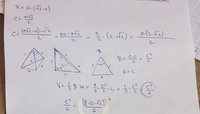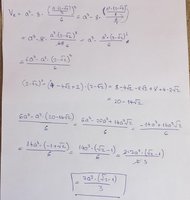Ana.stasia
Junior Member
- Joined
- Sep 28, 2020
- Messages
- 118
The question is:
The cube with a side a had all of its edges cut off so that each side of the cube has become an octagon with all sides equal. Calculate the volume of what remains of the cube.
The solution must be calculate through a with no other symbol involved.
Now it's clear to me that to get the volume of what remain I need to calculate the volume of the eight edges that have been cut off (those edges being pyramids) and subtract that from the volume of the cube.
This is the approach I tried to take.
Ve is the volume of what remains.


Now here is where I encountered a problem. I proposed that what I marked as c and what I marked as x are not the same because If they were the same then a=3x and x=a/3 when the edge of the pyramid is supposed to be a/2 * (2- square root of 2) unless the solution in the book is not correct. Also the next problem I encountered is that I proposed that a= x+ 2c, are the two Cs I marked possibly not the same? or do they have to be the same because octagon has all equal sides.

Here is how I tried to calculate the height. Now I am fully aware that my x does not the match the x from the solution, but I decided to try to calculate It until the end because a/2*(2- square root of 2) = a - a*square root of 2/2 which is very similar to what I got so I didn't rule out the possibility of a typo. The volume shown in the solution also includes *(square root of 2 - 1), so I decided to still try with the x I got.

This is the calculation of a volume which could possibly be shorten, however given I decided to leave it at this unless I am sure it's correct.
What mistake did I make in my calculations?
Thank you in advance
The cube with a side a had all of its edges cut off so that each side of the cube has become an octagon with all sides equal. Calculate the volume of what remains of the cube.
The solution must be calculate through a with no other symbol involved.
Now it's clear to me that to get the volume of what remain I need to calculate the volume of the eight edges that have been cut off (those edges being pyramids) and subtract that from the volume of the cube.
This is the approach I tried to take.
Ve is the volume of what remains.


Now here is where I encountered a problem. I proposed that what I marked as c and what I marked as x are not the same because If they were the same then a=3x and x=a/3 when the edge of the pyramid is supposed to be a/2 * (2- square root of 2) unless the solution in the book is not correct. Also the next problem I encountered is that I proposed that a= x+ 2c, are the two Cs I marked possibly not the same? or do they have to be the same because octagon has all equal sides.

Here is how I tried to calculate the height. Now I am fully aware that my x does not the match the x from the solution, but I decided to try to calculate It until the end because a/2*(2- square root of 2) = a - a*square root of 2/2 which is very similar to what I got so I didn't rule out the possibility of a typo. The volume shown in the solution also includes *(square root of 2 - 1), so I decided to still try with the x I got.

This is the calculation of a volume which could possibly be shorten, however given I decided to leave it at this unless I am sure it's correct.
What mistake did I make in my calculations?
Thank you in advance


